#caucaus mountains
Explore tagged Tumblr posts
Text

Brothers in Abkhazian mountain village Kuabchara, 2009 - Rob Hornstra
#abkhazia#abkhazin#abkazian#north caucasus#kavkaz#caucausian#caucasians#breakaway state#unrecognized states#caucaus#caucaus mountains#photography#photojournalism#Аԥсуаа#photojournalist#Аԥсацәа#фотожурналистика#eastern orthodoxy#Аԥсуақәа#global conflict#Апсуаква#აფხაზები#abkhazes#black sea#orthodox christians#eastern orthodox#christians#war#independence#social issues
70 notes
·
View notes
Text
to me romanians and moldovans living in the Caucasus is such a strange and esoteric concept even if it's not something recent at all. i read that romanian pastors (probably even back in Dacia), during transhumance, would migrate and reach southern Ukraine, Crimea and even north Caucaus (not sure if they reached the mountains but surely they must have been to Kuban river). i looked at some ethnic maps made during the Russian Empire and there was a sizeable Moldovan minority in modern-day Abkhazia, and in Krasnodar krai there are several villages named after moldovans... cool stuff. i'm going to be one of them ofc. i'll visit Georgia and Armenia 1000% and would love to go to Azerbaijan as well if it was less evil 💔💔💔
2 notes
·
View notes
Text
Note: I'm not a Caucasian, it's just an interest area of mine. I'm not citing sources, so much of what I say might well be misremembered, or numbers might be off, etc.. I'd be happy to accept any corrections or clarifications.
For anyone not aware, the Caucasus mountain range is located within and between Iranin the southeast, Turkey in the Southwest, and Russia in the north. The three main independent Caucasian countries are Armenia in the southwest, Geoegia in the northwest, and Azerbaijan in the east.
Most of the peoples of the Caucasus speak languages that are unique to it. In the north (Russian) Caucaus and Azerbaijan Caucasians are mostly muslims, while the rest -- Georgians and Armenians -- are largely part of an Orthodox church. Separate branches from the Russian one. Russians aren't native to the Caucasus, and the history of Russian colonization of the Caucasus I feel is pretty reflective of America's history of colonizing, well... modern day America.
Settlers from the home country leave their homes and settle in a place that's already inhabited (presumably because conditions at home are terribly oppressive or prospects are bleak) which causes friction with the natives. The big country has strategic interests in the region so eventually the settler on-native conflict transforms into an unwinnable conflict between the big country and disunited natives, and every so often the country commits unthinkable crimes against the natives.
The worst genocide Russia ever committed (in the Caucasus) is the Circassian genocide, where an entire ethnic/linguistic group was either killed outright or forced out of their native lands. If I recall correctly, this led to about 2 million dead, and far more suffering. To this day there's a large diaspora population of Circassians in Turkey today because of it.
Russia subjugated and settled the north Caucasus over the course of the 18th and 19th centuries. Lev Tolstoy makes a compelling fictionalized account of this time period in his final work, Hadji Murad.
I don't remember how Georgia or Azerbaijan were taken by Russia, so I'll skip over those. But Armenia is an interesting and tragic case. Before the existence of the country of Armenia, there were Armenians throughout the Ottoman Empire, though the biggest population centers were in the Caucasus, Istanbul itself (and one other iirc?). During the leadup to WW1, many Armenians were arguing for an Armenian homeland, much like many other European nation-states were getting. They faced awful conditions in the Ottoman Empire, and in the tail end of the 1800s, faced a... pogrom? A flareup of hostilities between other ethnic groups in the Empire which caused thousands of Armenians to die?
Later, during WW1, the Ottoman Empire would view Armenians -- *all* Armenians -- as traitors to the war effort, as supporters of Imperial Russia. Ottoman officials attempted to systematically exterminate and banish Armenians from the core territory of the Empire. Millions died on death marches, and Turkey has never acknowledged this genocide as being a genocide. The U.S. hasn't either, because Turkey is too valuable of an ally in NATO to piss off.
I'm not do familiar with the Soviet history of the Caucasian countries, but in the modern day, Armenians are still under threat from an aggressive Azerbaijan. The Azeris recently seized the territory of Nagorno-Karabakh by subjecting it to a cruel siege. North Caucasians, Caucasians in Russia, are subject to housing discrimination in many parts of Russia, especially Moscow. Landlords will sometimes put up signs that they only want slavs as tenants. So, Russians, Belarusians and Ukrainians.
Chechenya tried to break away from Russia while the Soviet Union was collapsing, but Russia -- Yeltzen and later Putin -- refused to let it go. The Russian state relies on oil eevenues from the Caucasus so much that they declared two separate wars on Chechenya, where theu leveled the city of Grozny to the ground.
And in 2008, Russia invaded Georgia under the pretense of liberating and uniting Abkhazians and Osetians. To this day, Russia looms over Georgia like the U.S. does over many central American nations. Right wing politicians fearmonger that they can't enact *any* policy that might anger Russia, and in fact have to model their authoritarian laws after Russian ones because of the threat posed by them.
its insane how you literally can't talk about the oppression caucasians face (what was the last time you read about the genocide or imperialist aggression caucasian people went through? actually?) without an american/westerner piping up with "umm... lol... you think White people are oppressed? lol"
Isn't it crazy how people use caucasian to make fun of white people while literally Completely erasing the struggles of a racialized group? Isn't it crazy how no one cares and people keep doing it without batting an eye? And isn't it crazy when you try to look up something about caucasians you get stupid ass articles about "are white people opressed or not? are white people entitled? are white people this or that?"
147 notes
·
View notes
Video
vimeo
Travel to the snowy Caucasus mountains of the nation of Georgia along with a group of snowboarders in this video. They're truly surrounded by amazing landscapes the whole way down.
#caucaus#mountain#mountains#georgia#geology#snow#nature#snowboarding#snowboard#sport#video#ride#russia#planet#vimeo#travel#the earth story
37 notes
·
View notes
Photo

Georgia
#georgia#sakartvelo#racha#ghebi#caucaus#caucasus mountains#mountains#Georgia on my mind#nature#illustration#nature illustration#digital drawing#digital art#digital illustration#graphic art#artists on tumblr#Livija Viksna#livijaviksna#silhouette
10 notes
·
View notes
Note
White humans actually are somewhat programmed to be on the internet for hours because they fucked neaderthals in the caves of the caucaus mountains...and they couldn't leave the caves for long periods of time during the winter
???
2 notes
·
View notes
Note
I agree! I also see Jack as having some strong Taurus elements because oofhis stubborness and his need to remain anchored to reality (the man of science of it all).
However, apart from it being canon, Jack as a Sag makes sense because his whole journey is the Sag journey: to go beyond certainty, to explore reality, to engage with the themes of faith and healing.
Healing is also closely associated to the Sag archetype and of course Jack is not only a doctor, he's THE doctor with almost miracle-like qualities (another relevant theme to the underlying myth of the Sag, Chiron).
Chiron is the wounded healer and I think this could also be the perfect description for Jack. Chiron also sacrificed himself to free Prometheus from his chains on the Caucaus mountains: someone had to stay there to suffer and Chiron, mortally wounded but unable to die because of his immortality, offered himself up.
So Sag really is the best sun sign for Jack because it represents his need ttostay grounded (the Sag is half-horse, half-human) and earthbound (the horse part) and his call to have faith, trust the unknownd and "go beyond" (the human part of the Sag is an archer, the symbol of exploration).
Lost writers had a superb understanding of archetypes and symbolism so it was 100% intentional, I think!
Can you talk a more about Jack’s astrology? Why do you think he’s a Sag, I would imagine him more as a Virgo.
Okay so, I had to consult with my friend who’s a lot better at astrology than I am (I mostly go on vibes based on the people I know lmao).
But, as for Jack being a Sag, I mean that’s canon , his birthday is December 3rd. And idk him being a fire sign just makes sense; Aries is aggressive in a way that I don’t think aligns with Jack, Leo needs to be the center of attention in a way Jack isn’t. So that leaves Sag.
Now, it’s interesting that you brought up Virgo, because I think Virgo’s is too emotionally stable for it to be Jack’s sun, but my friend and I can see him having a Virgo moon because there’s obviously the need for control every step of the way.
Jack’s big 6 (according to me and my friend) are:
Sagittarius Sun
Virgo Moon
Taurus Rising
Cap Mercury
Scorpio Mars
Cap Venus
#i don't know about virgo moon bc jack and emotions and control don't go hand in hand#i'd say a water sign. cancer is too motherlike. pisces is too romantic. so i think scorpio moon#since jack feels everything sooo sooo deeply he can't contain his emotions at times#but he's also able to command them (eg his mantra about fear) bc of his profession so i'd say that his moon is in good aspect#with something else related to the external and the career.#lost tv series#lost abc#lost#lost 2004
10 notes
·
View notes
Text
A World of Dinosauroids
C. M. Kosemen with Simon Roy
My post on Simon Roy’s “Dinosauroids” is one of the most reblogged things on this blog. I love the concept because it rewrites the cosmic tragedy of the K-T Mass Extinction Event, resurrecting dinosaurs and projecting their continued evolution in ancient world that is alien but also eerily resonant. Recently Simon turned me onto The-Master-Post-on-All-Things-Dinosauroid on his long-time collaborator, C. M. Kosemen’s, site. The following post has been transcribed from C. M. Kosemen’s blog and formatted for Tumblr with @simon-roy‘s blessing.
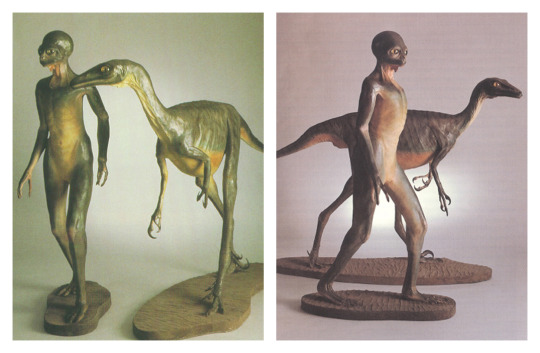
There are two highly-popular, vexing questions about dinosaurs: What would the world look like if these strange and majestic animals had not gone extinct? And, would they ever evolve into intelligent species comparable to humans? In 1982, palaeontologist Dale Russell, after observing “… a general trend toward larger relative brain size in terrestrial vertebrates through geologic time, and the energetic efficiency of an upright posture in slow-moving, bipedal animals”, postulated the Dinosauroid, a humanoid, erect-gaited sophont which may have evolved from Troodon-like dinosaurs had the end-Cretaceous extinction not occurred.

This question occupied the minds of yours truly (seen here on the right), and world-building comic genius Simon Roy (on the left), as well. We were unconvinced by Russell’s Dinosauroid. We thought that an erect, humanoid sophont was too prejudiced towards humans to be realistic. We were instead inspired by zoologist Darren Naish’s writings on the evolution of intelligent, bird-like dinosaurs: “No, post-Cretaceous maniraptorans wouldn’t end up looking like scaly tridactyl plantigrade humanoids with erect tailless bodies. They would be decked out with feathers and brightly coloured skin ornaments; have nice normal horizontal bodies and digitigrade feet; long, hard, powerful jaws; stride around on the savannah kicking the shit out of little mammals; and in the evenings they would stand together in the trees, booming out a duet of du du du-du, a deep noise that would reverberate for miles around…”
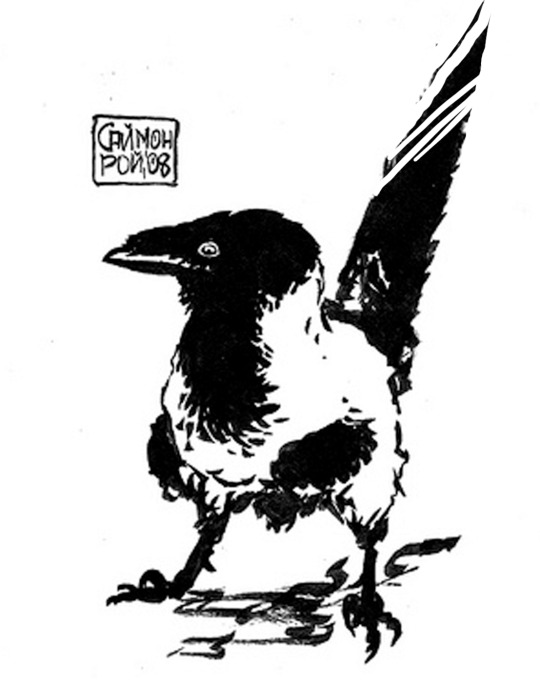
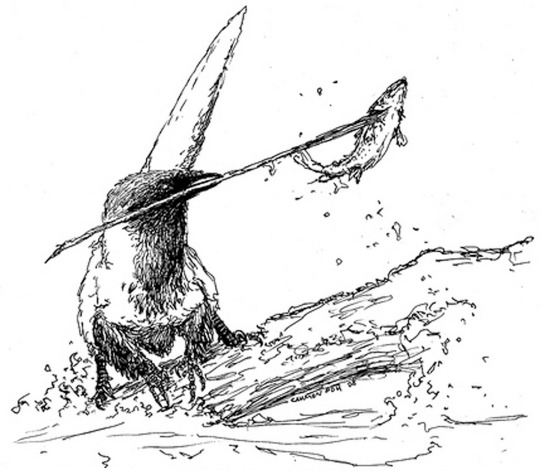
Towards the end of the ‘00s, Simon Roy and I independently began to develop our concepts for bird-like intelligent dinosaurs. Inspired by the ravens he saw around his Canadian home, Simon drew the corvid-like dinosauroids seen above.
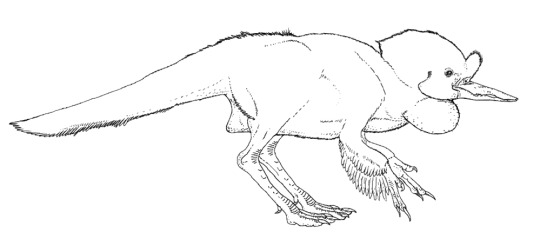
I, in turn, was inspired by ground hornbills, parrots, certain dinosaurs and corvids, and came up with the speculative organism seen above. I named it Avisapiens saurotheos. Simon and I soon got in touch with each other; and started developing a world and a storyline for our dinosauroids. Our collaborative efforts continued, on-and-off, until the mid-2010s. Our aim was to develop the Dinosauroids story into an illustrated story-book, which we naively hoped to sell to a major sci-fi publisher. But we soon realised that we enjoyed world-building more than writing a story, or putting a book together. We kept bouncing concepts back and forth, but never had a chance to publish them, until now. Most of the body of work you see on this page was drawn by Simon, based on ideas we created together. I also contributed some of the “cave drawings” and certain creature illustrations. This is the first time the totality of our Dinosauroids-universe works has been displayed online.
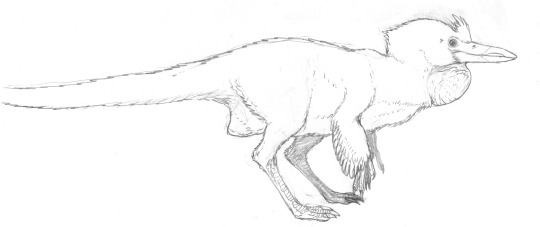
Simon and I refined the design of my original Avisapiens dinosauroid…
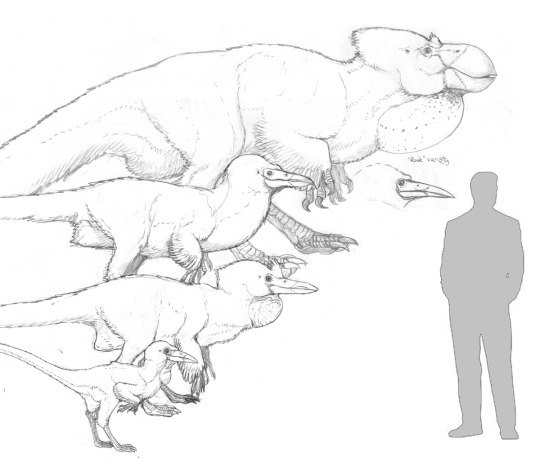
And created a few more sentient races to accompany them. There was one more, slightly-crow-like species of Avisapiens (a continuation of Simon’s corvid dinosauroids - Avisapiens tataricus). These two species were joined by a variety of “forest giants” (Gigantosapiens borealis), and a race of pygmies (Avisapiens minimus).
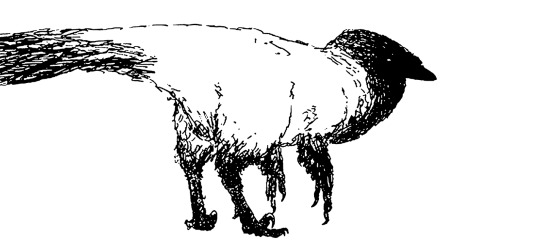
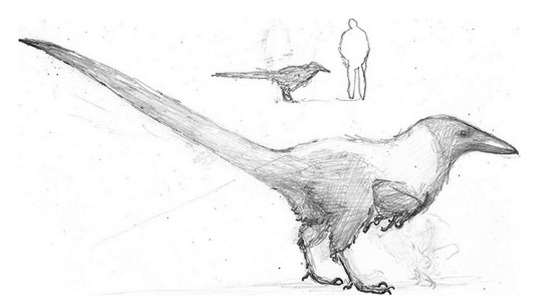

Simon’s refined studies of corvid-like, and pygmy dinosauroids.
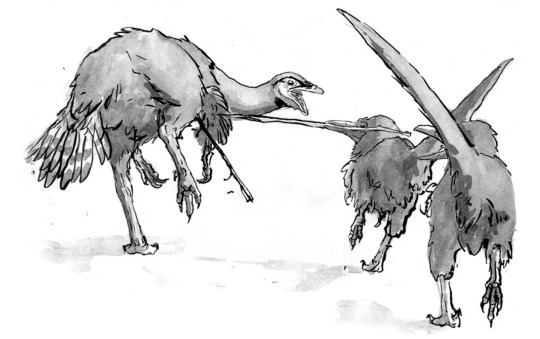
We also designed an extensive selection of animals around our dinosauroids. We predicted that even without the K/T mass extinction, dinosaurs and other animals would have kept on evolving, and many “familiar” groups of dinosaurs would have gone extinct. We thus designed a world where the majority of surviving dinosaurs were the descendants of “maniraptoran” groups; birds, deinonychosaur (“raptor”) dinosaurs, troodonts, oviraptors and therizinosaurs. Here, you can see two boreal dinosauroids using mouth-spears to hunt herbivorous troodont quarry.
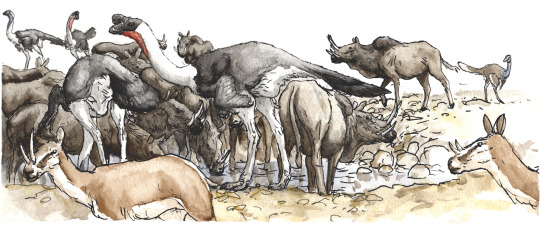
We also did not want this world to be devoid of mammals. Even during the age of dinosaurs, certain mammals evolved into large and sophisticated forms. We envisioned a world where parallel groups of mammals, similar to, but phylogenetically distinct from today’s forms, co-evolved alongside the dinosaurs during their continued reign. The scene above shows an Eurasian water-hole crowded with two species of ornithomimid herbivores (Rugocursor, left-centre; and Cyanogularia, far right); alongside robust (Afrotuberculocamelus) and gracile (Odontocervoides) species of herbivorous mammals which, for the lack of a better term, we decided to name “supermaras”.
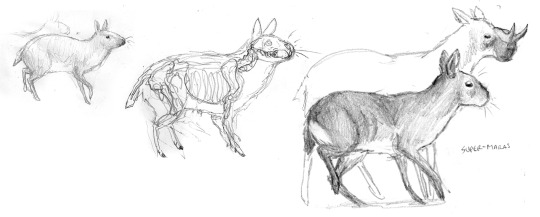
A series of studies showing the evolution of supermaras from rodent-like multituberculate mammals. The species depicted here is Ceratomegamys.
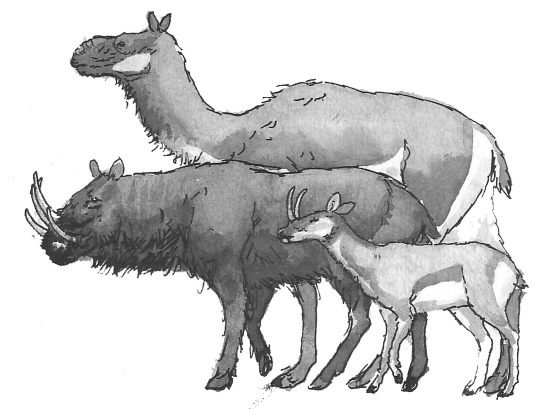
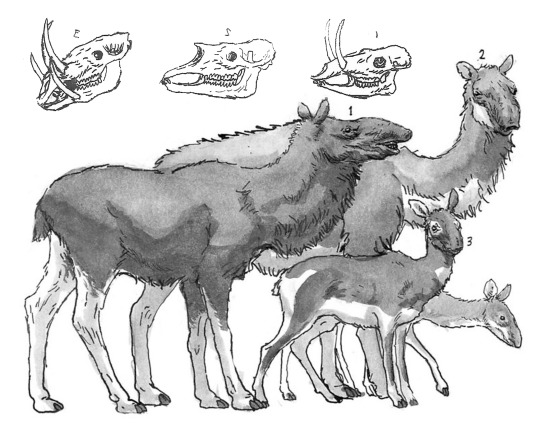
The full diversity of cursorial “supermaras”, from left to right: The burly, tusked Odontobovis; the superficially-camel-like Tuberculocamelus; the gazelle-like Odontocervoides; the trunked, moose-like Pseudalces; and the two related forms - the big, desert-dwelling Macropseudalces; and one of the many deer-like Cervopseudalces species.

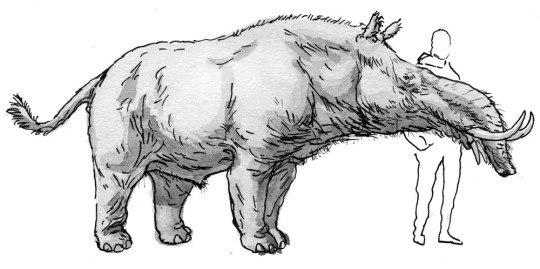
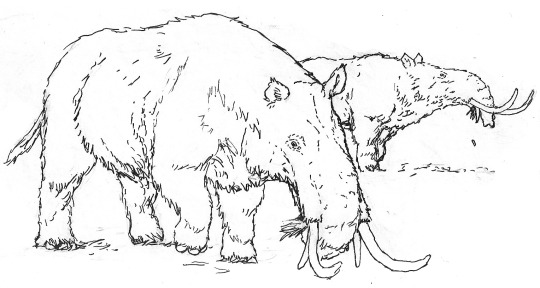
Studies of Megatapirus, large, superficially-elephant-like mammals that live in far-northern climates.
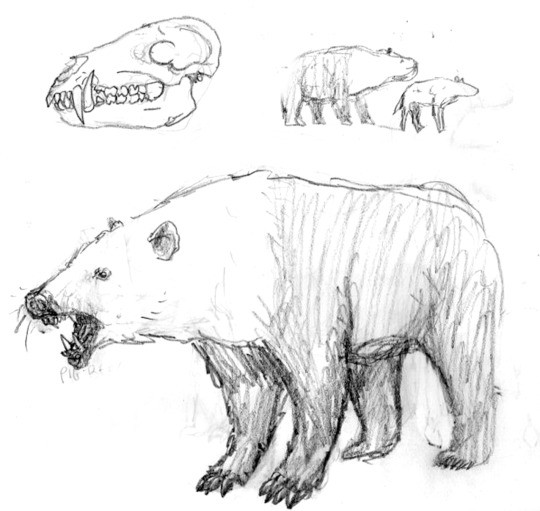
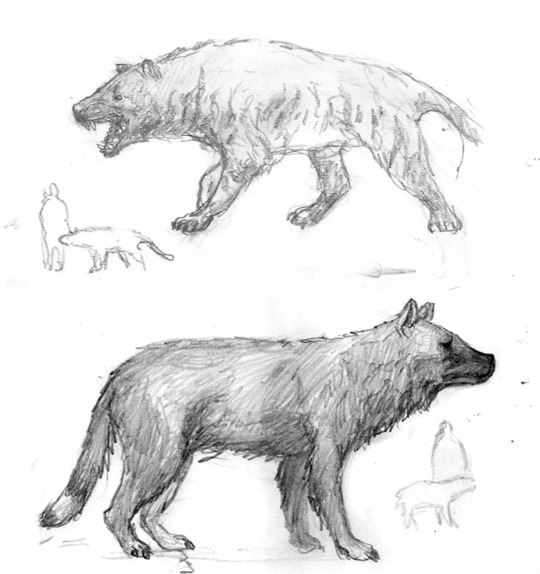
We also derived a variety of mammalian carnivores, mostly from marsupial stock. Through the honing forces of evolution, we imagined some would look very similar to the canid predators we have in the present day - the actual difference would only be in their internal and reproductive anatomies. Above, clockwise: The large, badger-like Mephitursoides; the extremely dog-like Pseudokynos; the hyena-like Krokutadasyurus.
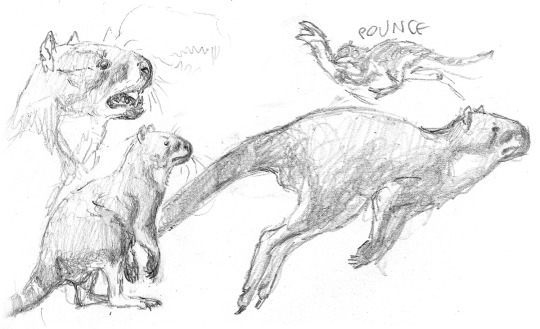
Some marsupial predators diverged from the mammalian body-plan, and evolved into forms roughly converging with the predatory dinosaurs. The raptorial, meat-eating kangaroo-equivalent Theropodoktonos and kin are potent predators in South America.
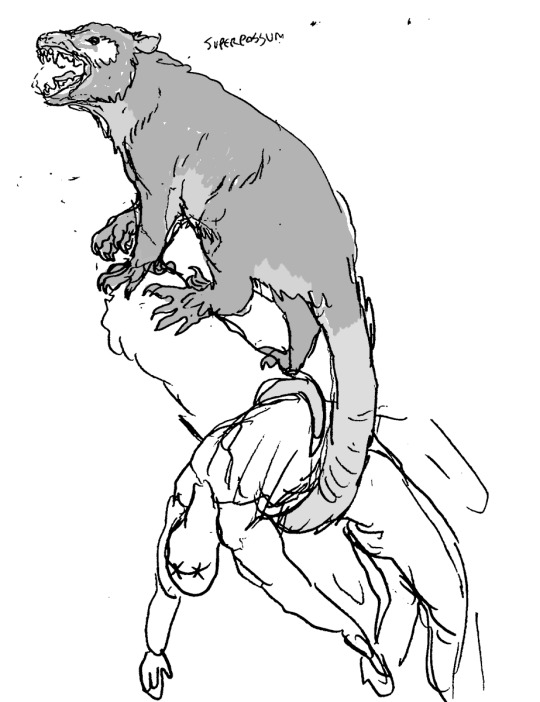
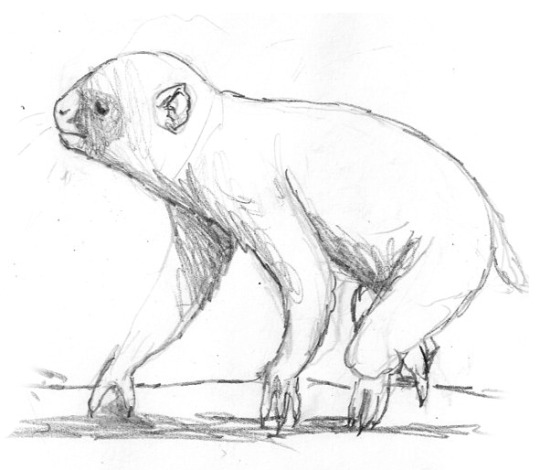
Two more divergent marsupials: The leopard/possum Phobodidelphyoides; and the monkey-like Marsupiolemuris, a social, arboreal form with a potential to evolve intelligence.

We also wanted to have flying reptiles - pterosaurs - still alive and kicking in our world. These extraordinary animals were already in decline by the time dinosaurs became extinct. So we relegated them to only a few roles, comparable to storks and other large water-birds alive today. Above is a flock of Diluvipterus; large, filter-feeding pterosaurs. Also note the solitary duck flying on the upper-left corner.
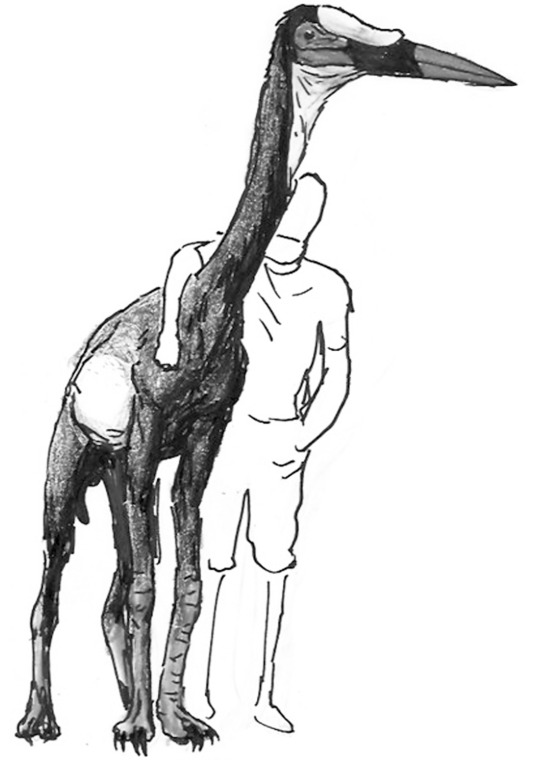
Another, flightless pterosaur, Cygnotherium, from the islands that now make up New Zealand.


A more unusual group are the avisuchians, descendants of maniraptoran dinosaurs that secondarily converged on the aquatic bodyplans of spinosaurs (which are now extinct in this timeline). Most resembled the short-tailed forms, Pisciraptor and Brachyornithoides seen above. These goose-to-dog-sized animals inhabit rivers and lakes, and occupied a niche comparable to otters today.
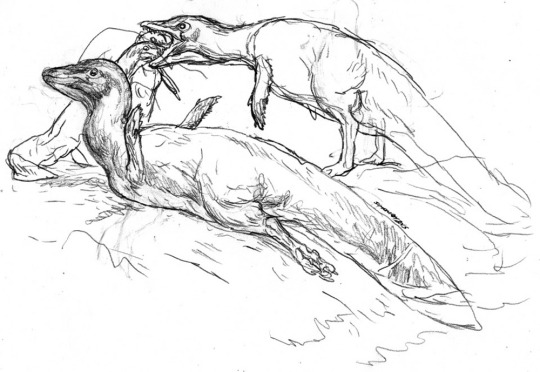
There were also long-tailed Avisuchians such as the Natatoraptor seen above. These animals inhabit open waters, and nested in estuaries and beaches.

A contemporary scene from Eurasia shows commensal life between mammals and dinosaurs. Two Pseudalces browse peacefully alongside two kinds of large ornithominids, Archganseria and Brontonyx. A tiny, heron-like troodont, Anatolocursor, can be seen between them, looking for small animals flushed out by the large herbivores’ movements.

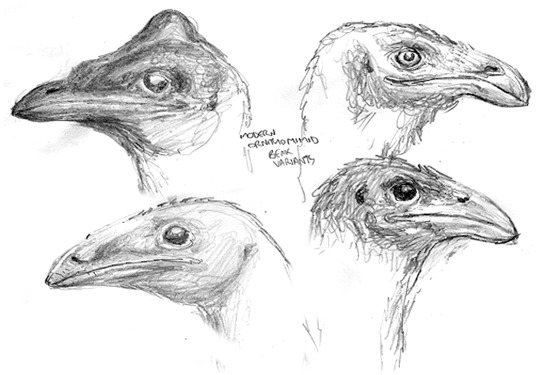
Nevertheless, despite co-existing with large mammals, dinosaurs are more diverse on this world. Herbivorous dinosaurs, such as these derived ornithomimids, constitute a large part of dinosaurian diversity. Above left are studies of Ganseria, a common, medium-sized browser. Above right, clockwise from the top right, are portraits of Ukkuloganser, another medium-sized browser; Nyctodromon, a nocturnal digger; Adzuganser, a small omnivore; and Pyramidoganser, a crested form native to the Nile Delta.
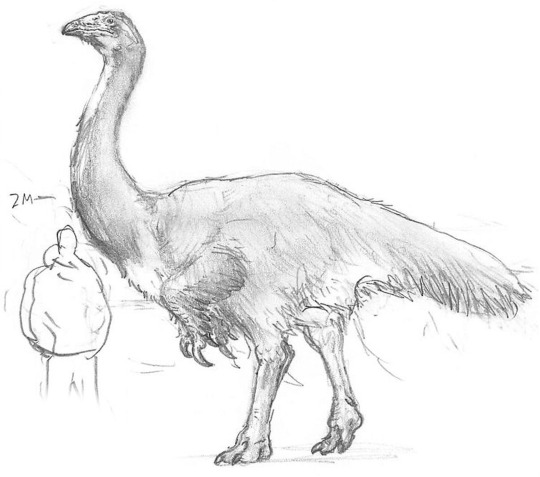
A scaled study of Brontonyx, a heavyweight ornithomimid herbivore.
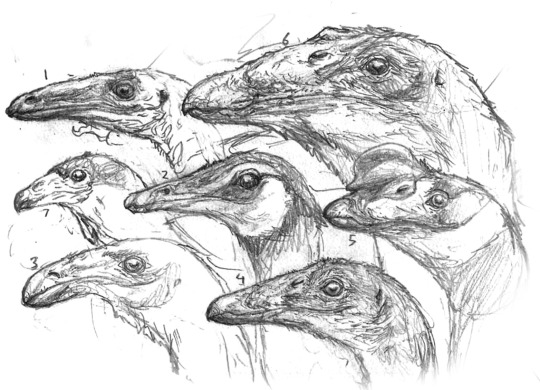
Portraits of many cursorial dinosaurs from across Eurasia: 1- Leptoganseria, a mountain-dwelling ornithomimid browser found on the mountains of what is now the Caucaus. 2- Ikiridectes, a troodont that mostly hunts small digging mammals. 3- Aktardektes, a small ornithomimid that has specialised for cracking hard-shelled nuts. 4- The gracile, juvenile variant of Brontonyx, (6) which occupies a completely-different ecological niche as a generalist omnivore. 5- Rugocursor, a widespread, broad-beaked ornithomimid with many species, common across North Africa and Eurasia. 6- The adult form of Brontonyx, a gigantic ornithomimid that feeds on trees, and defends itself with heavy claws. 7- A vulture-like Cynornithoides, an extremely bird-like troodont, a frequent commensal of Avisapiens and related intelligent species.
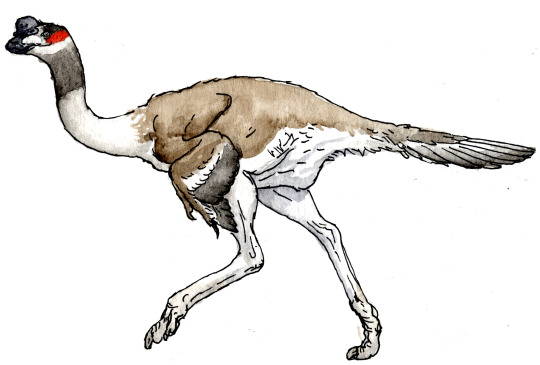
A variety of Rugocursor, a mostly-herbivorous ornithomimid with adaptations for running.
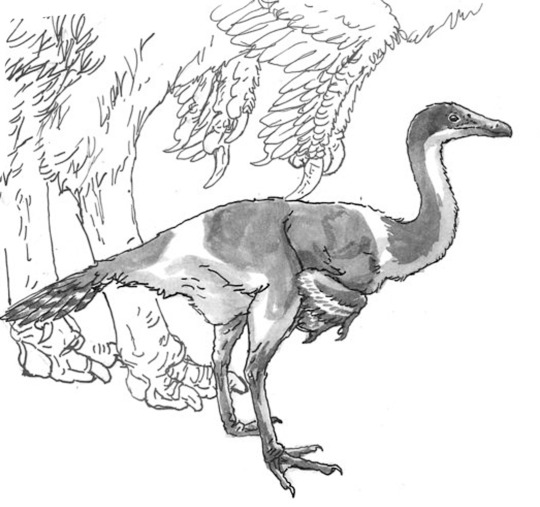
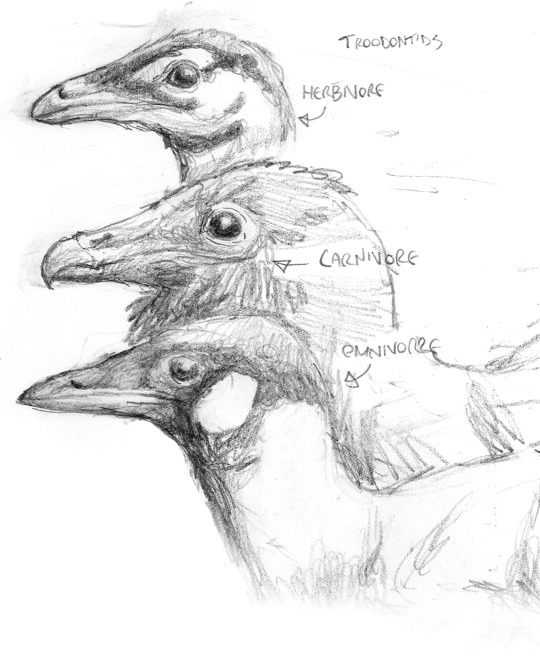
Various troodonts, small-bodied, sometimes very bird-like omnivorous dinosaurs, distantly related to the Avisapiens lineage. Left, shaded study of Variocursor, a common, heron-sized, striding predator on small animals. Right, from top to bottom; Vuuria, a herbivorous form common across Eurasia; Boreocursor, a cold-climate predator, related to the Variocursor seen on the left; and Paravuuria, an omnivorous form.
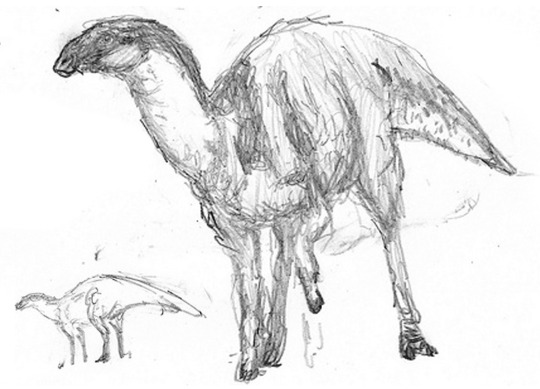

The last descendants of hadrosaurs, the famous “duck-billed dinosaurs”, still roam in South America. The hoofed, sheep-sized Ornimastax seen above left, is a typical example. Australia, as in our world, is home to an unusual radiation of forms whose relations to animals on other continents are not very clear. Brachygullagong, seen above right, is a troodont-like form whose duck-like skull and batteries of grinding cheek teeth have secondarily converged with those of the hadrosaurs.

The largest herbivores on this world are long-necked, scythe-clawed ornithomimid relatives known as avititans. The largest species on Eurasia is Avititan bicolor, seen above in scale with a human figure.
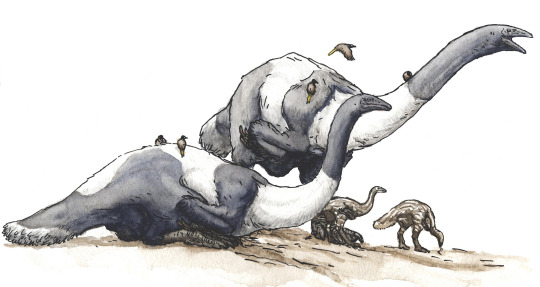
Avititans owe their ecological success to their strong social structures and their care of their young. Here are two Eurasian avititans with their offspring. Yellow-tailed enantiornithine tick-birds, Parasitophagus leucurus, can be seen on their backs.
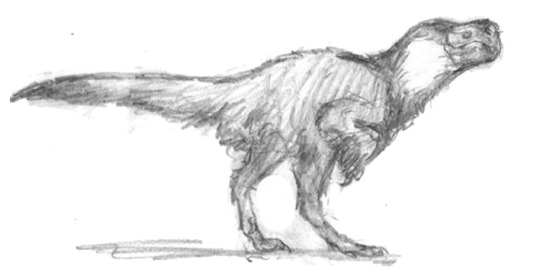
Oviraptoriformes made up another important clade of dinosaurs in this world.

Descended from bird-like ancestors, various clades of these animals live on as important omnivores, scavengers and even predators in many ecological niches. Above is Eblisornis, a common species found throughout Eurasia.
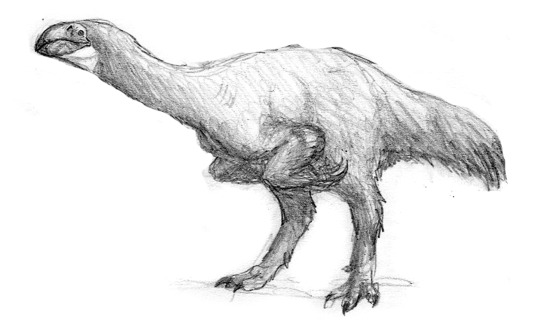
The bull-bird, Bosornithoides erythrops, is the largest and most prominent oviraptoriform on the Eurasian continent. It subsists mostly on plants and fruit, but will eat carrion if given the chance.
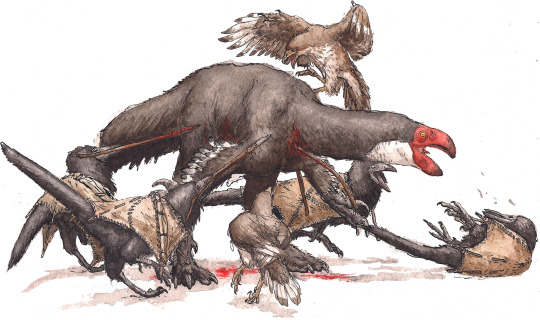
Hunting the wary and dangerous Bosornithoides is an important rite of passage for dinosauroids. The animals require coordination and group-work to bring down, and hunting one is a bonding experience for batches of young-adult nestmates. This ritual not only cements the dinosauroids’ social standing in their tribe, but also bonds the hunters together for the rest of their lives. The four hunters-to-be in this picture are accompanied by a couple of jackal-birds (Cynornithoides), domesticated pets that are almost as smart as the dinosauroids themselves.
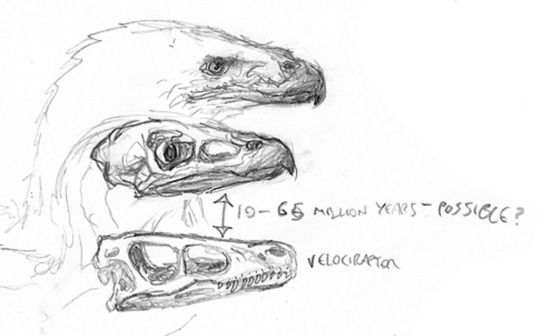
Many dinosaurs dabble in carnivory, but the main predatory niches on this version of Earth, are occupied by a diverse radiation of paradromaeosaurs, descendants of the famous “raptor” dinosaurs and kin. Paradromaeosaurs have diverged considerably from their ancestors. One lineage, known as the rhynchovenators, replaced their teeth with sharp, raptorial beaks.

The male and female of the common boreal rhynchovenator, Rhynchovulpes agilis.

A lean-legged Egyptian rhynchovenator, Rhnychovulpes aegypticus, atop a dead multituberculate mammal. The key to rhnychovenators’ success is their added tenacity and stamina. Even a small rhynchovenator can overcome comparatively large prey by continually harassing and chasing it into exhaustion.
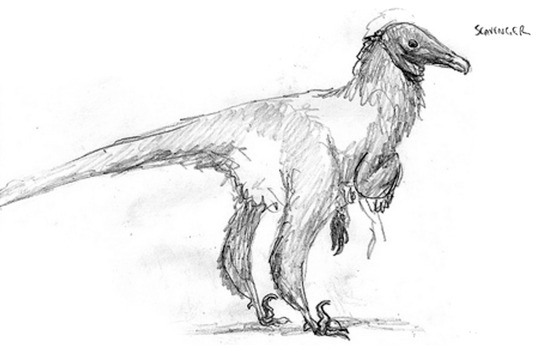
The bald-headed Osteophaganax regalis is a common scavenger encountered across the Caucaus Mountains. Its males develop striking, black-and-purple wattles on their faces during spring.
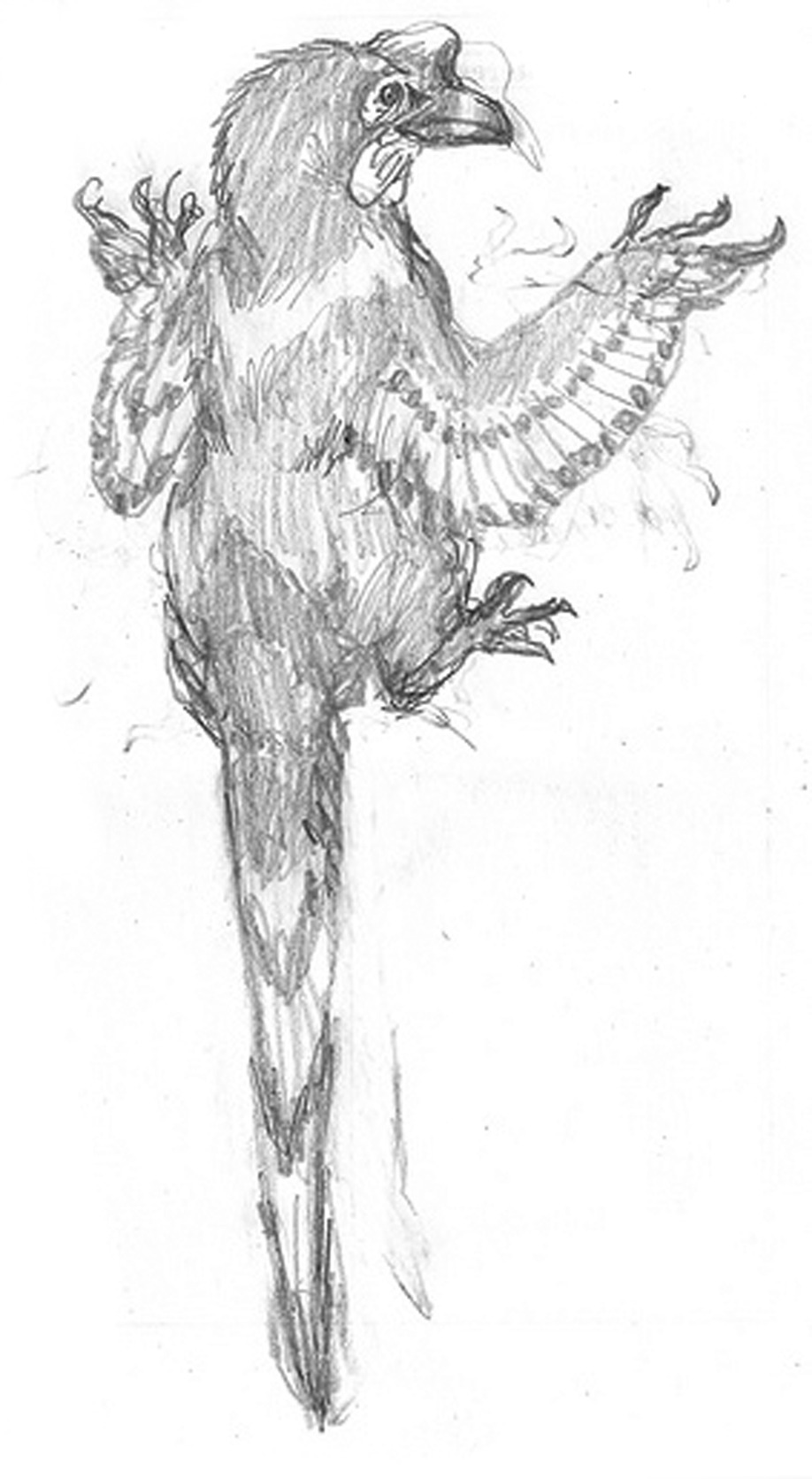

Two more derived troodonts. Left, a tree-dwelling arbosaur, Toucanops dixoni, from one of the diverse and little-understood clades found across the South American continent. Right, the lean, narrow-beaked Halophagus sp. from fossil deposits in what is now China. This group evolved specialisations for marine diving and probably saltwater drinking, before becoming extinct during the Miocene.
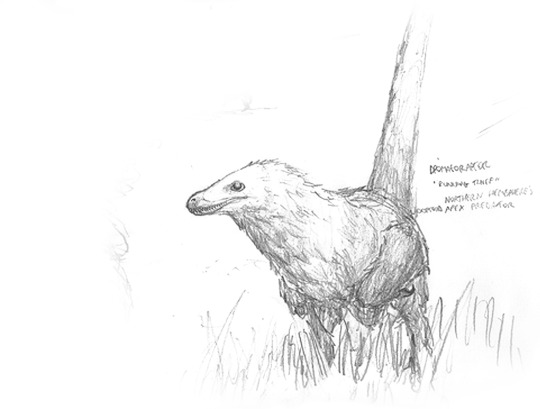
The dominant guild of maniraptoran predators, the tyrannoraptors, evolved from “regular” dromaeosaurs with powerful, biting jaws. Some species living today, such as the Savannahdromeus shown above, are still very similar to the earliest forms. Despite its small size, the smart and social Savannahdromeus are apex predators thanks to their pack-hunting behaviour.

Another basal tyrannoraptor, Pantherdromeus - is a solitary hunter that is common across much of Eurasia. It probably represents a diverse and subtly-variable species complex.

Solitary, basal tyrannoraptors eventually gave rise to the terrifying main-line tyrannoraptors in the last twenty-million years. The evolution of these animals was marked by the reduction of their wings and the enlargement of their legs, and jaws. Their tails developed into stiff and rod-like balancing organs. In some respects, they were the evolutionary echoes of the big-jawed, running tyrannosaurs, which had become extinct earlier on, during this world’s version of the Eocene period. Unlike tyrannosaurs, however, tyrannoraptors had well-developed social behaviours and intelligence; which, when coupled with their fast speed and terrific jaws, turned them into formidable apex predators. Above are the adolescent and mature forms of Metadromodaemon phobetor, a mid-sized hunter found in the Middle East and North Africa.
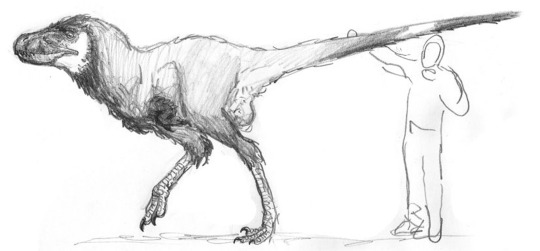
A scaled drawing of Wotandromeus bicolor, the terrifying, large-headed hunter of European forests.
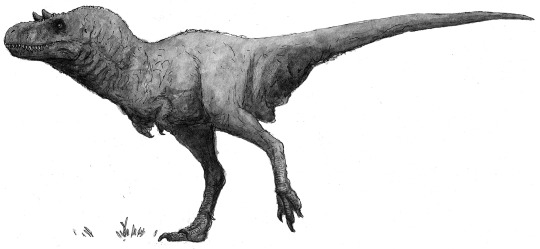
The seven-metre-long Melanorodromeus euceratus - also known by the Dinosauroids as “black thing” - is the largest predator on mainland Eurasia; but even larger forms are reputed to exist in Siberia and North America.

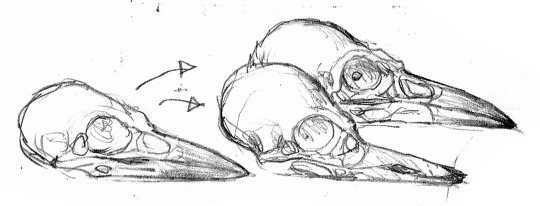
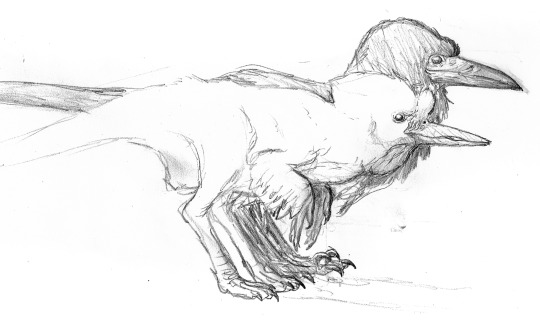
Let us now return to the Dinosauroids, their culture, and art. Above is a brief study illustrating the divergence of the two species of Avisapiens; A. saurotheos and A. tataricus, from ancestral eu-troodontid stock.


Especially A. tataricus shows considerable variation in beak shape, length and colouration. Above, right are the colouration of the Eurasian (top right, bluish-black), and Northeast Siberian (above right, yellowish-brown) races. Above, left shows a spectrum of variation in A. tataricus beaks. The cross-beaked and long, curved beaks occasionally crop up in certain bloodlines, which also have augmented song-memories. These individuals are revered as shamans in certain A. tataricus tribes; or are immediately killed-off as harbingers of doom in others.
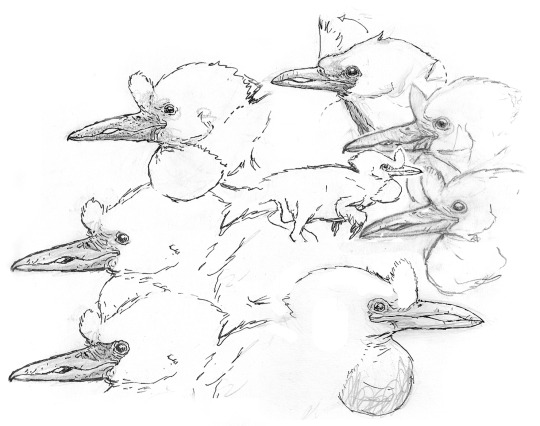
Above, the extensive variation in the head shapes, beak lengths and crests of various races in A. saurotheos. The bottom-right sketch depicts a hybrid individual between A. saurotheos and A. tataricus.
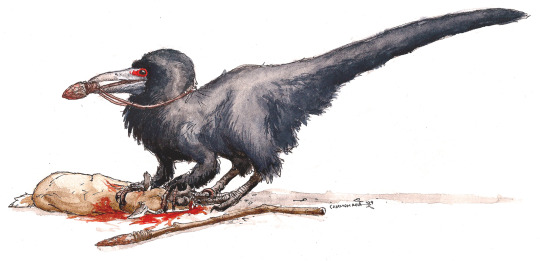
A powerful hunter of A. tataricus, from the Carpathian Mountains, showing a stone axe and bent spear that are characteristically used by this particular tribe.
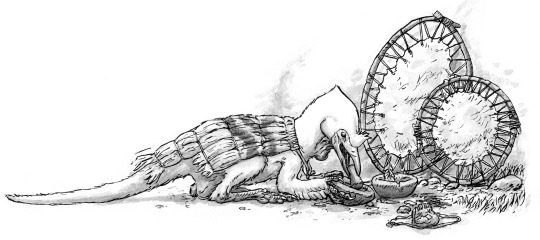
An artist/shaman of one of the settled A. saurotheos tribes living around the Balkans. He paints on animal skins stretched taut across circular frames, and paints using ground-up soil and other pigments, wielding a brush made from a wing-feather. The skin canvas also double as drums.
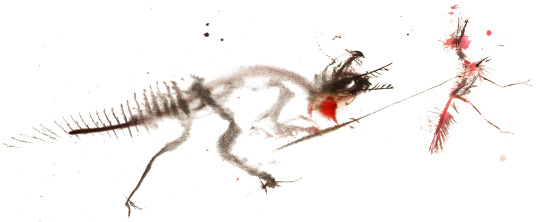
Art is one sure-fire way of identifying an intelligent species. This skin-painting shows a spear-hunter and prey, a painting by the aforementioned shaman.
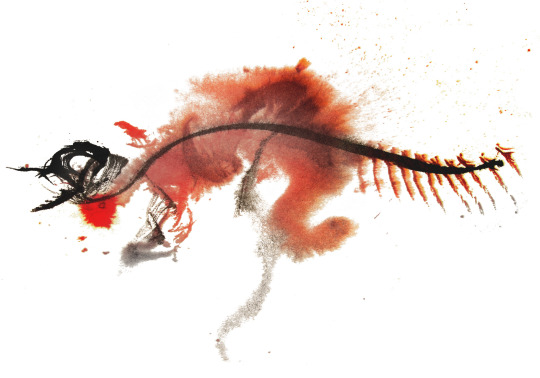
Painting of a god or hero-figure with red tail feathers.
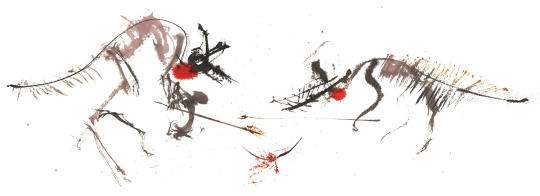
Painting of two shamans divining the future from the entrails of a dead flying animal.
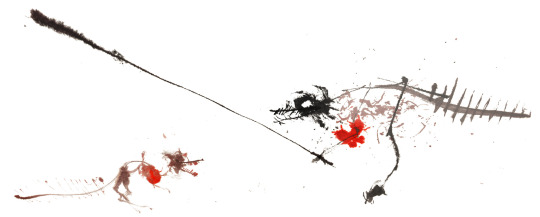
Painting of a hatchling being trained by a village elder.
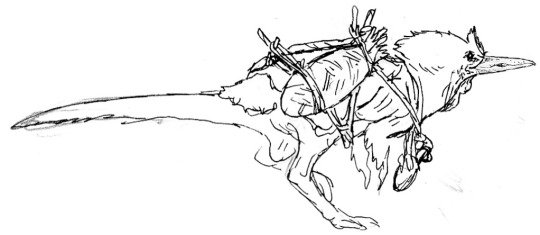

Studies of an A. saurotheos wanderer with a travel harness; and a duo of A. tataricus migrants with a domesticated bull-bird, a relative of the oviraptoriform Bosornithoides mentioned above.
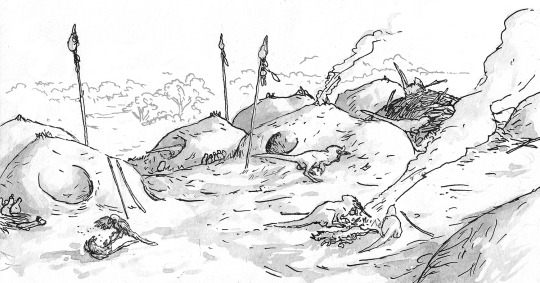
The view from an Avisapiens saurotheos village, showing the species’ characteristic nest-houses, and a pair of semidomesticated Cynornithoides jackal-birds playing in the village square. Note the heads mounted on tall poles, a sign of reverence to the spirits of the departed.
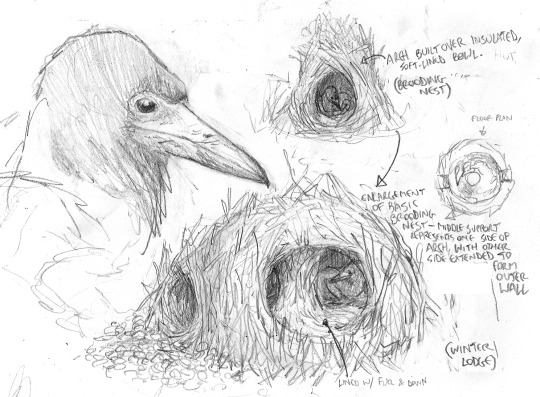
Detail of a brooding nest constructed by Avisapiens tataricus. Most tribes of these species are migrants that range across Eurasia, few build permanent structures.
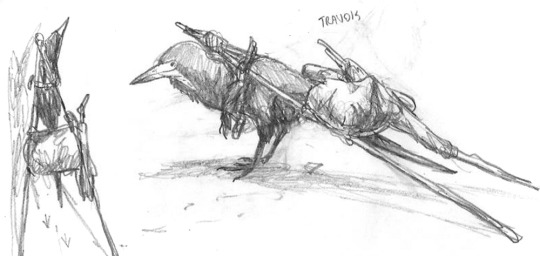
Sketch of an A. tataricus wearing a travois-like travel harness.
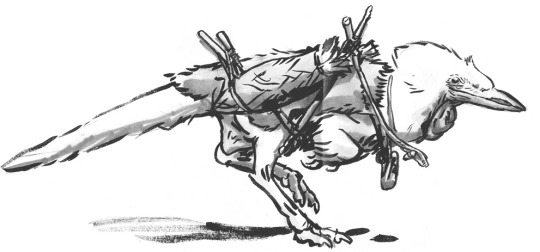
Study of an A. saurotheos wanderer with travel gear.
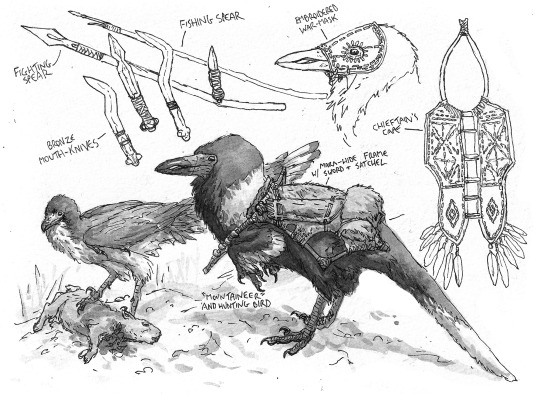
A detailed study of the burly A. tataricus native to the Caucaus Mountains, complete with weapons, travel gear and ornamental cape.
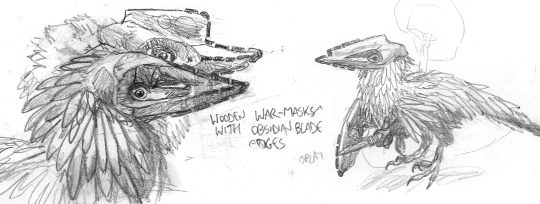
Sketches of war-like A. tataricus tribes native to the Eastern Mediterranean region. These tribes are known for their ferocious (if impractical) war-masks.
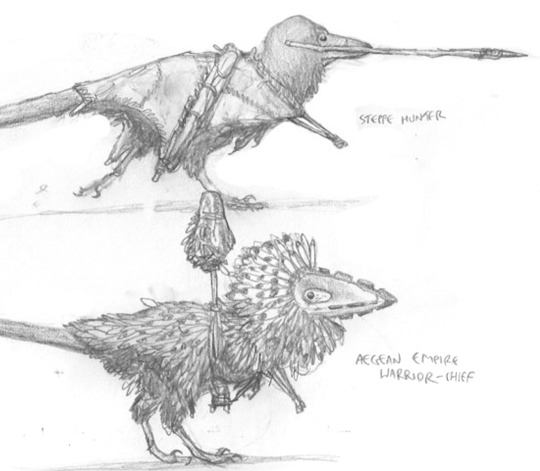
Studies of two different warriors from two different Avisapiens tataricus societies.
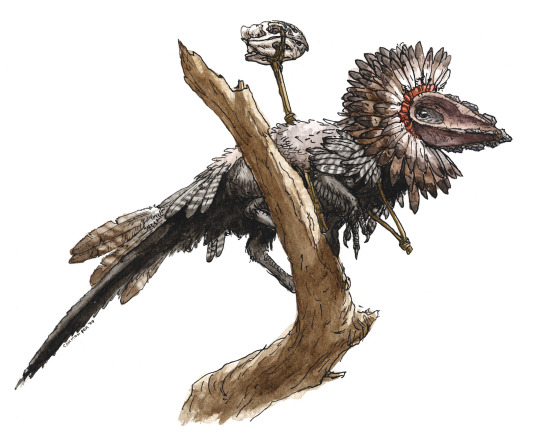
A resplendent A. tataricus warrior from the Levant, wearing an ornate head-dress of feathers, and an obsidian-studded war-mask.
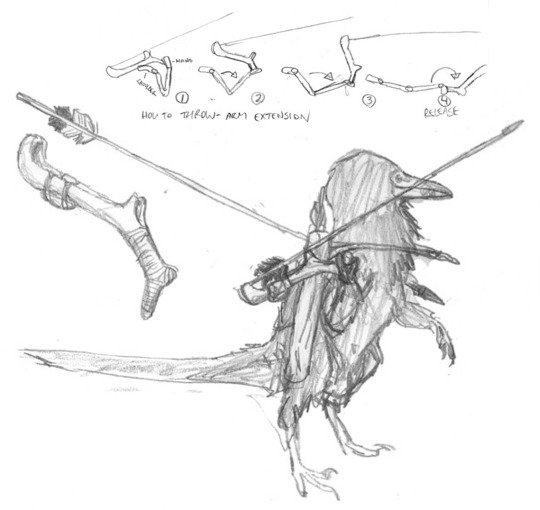
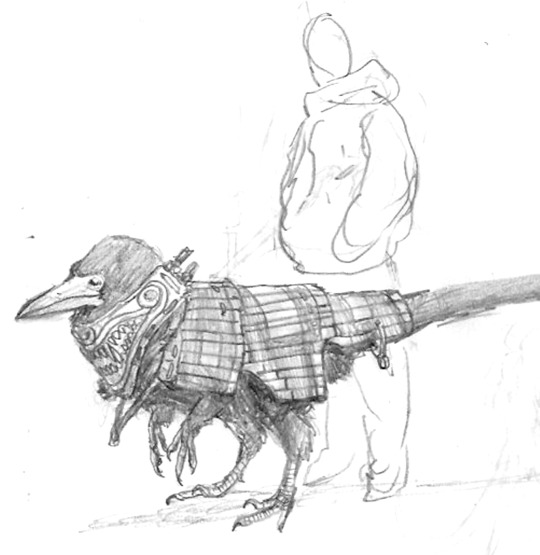
Studies for Avisapiens spear-throwers and wooden-slat armour; from a comparatively advanced period on this species’ societal development.
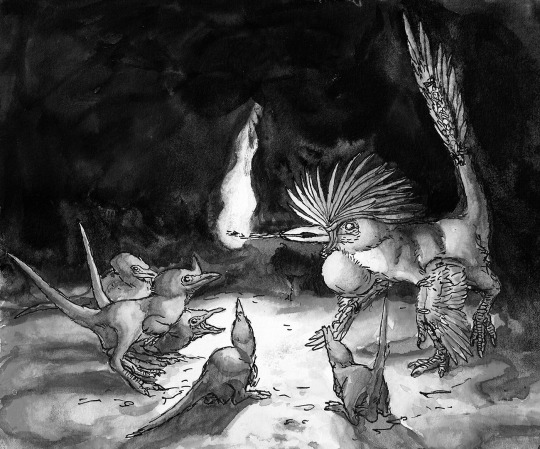
An A. saurotheos shaman entertains hatchlings with fireside tales of spirits and other worlds.

A band of slave-keeping A. tataricus warriors during a raid to an A. saurotheos village. A young shaman is captured and de-clawed.

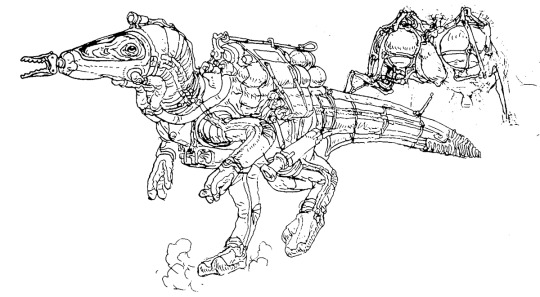
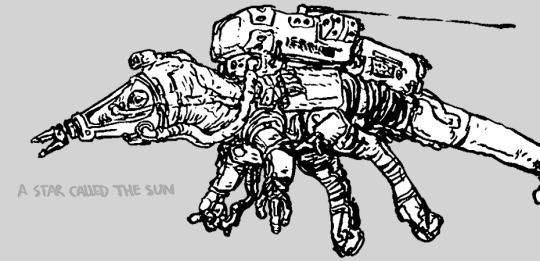
Simon Roy and I also dwelled on the far-future evolution of dinosauroid technology. The sketches above of a “knight”, moon lander and an astronaut were produced, but we did not pursue these scenarios seriously.

Let us conclude our visit to the dinosauroid tangent-universe with one last look at our artist/shaman, his village, and his paintings. Somewhere in deep time, they are still alive, and still waiting to tell us of their adventures.
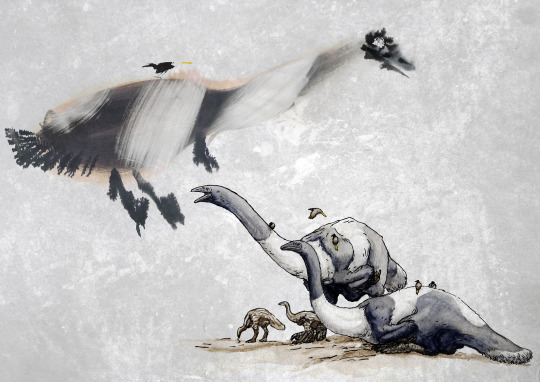
A painting of an avititan family.

A painting of the dangerous, predatory “black thing”.
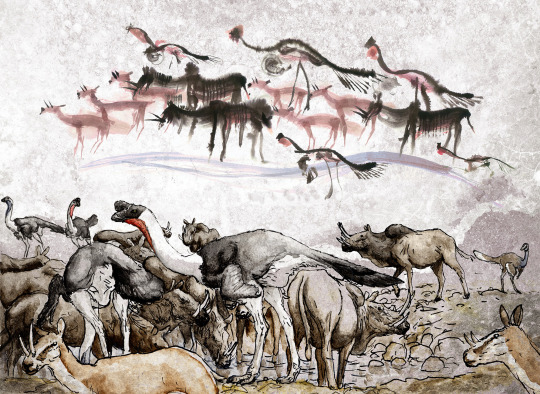
A painting showing numerous animals at a watering hole.
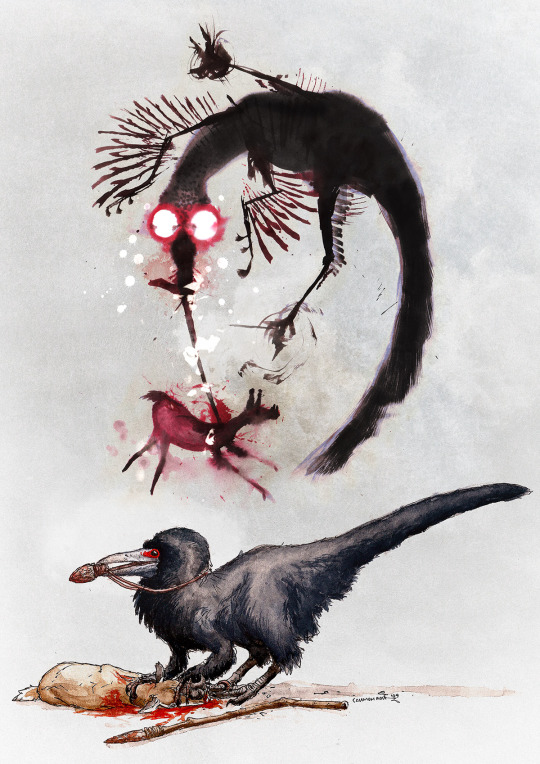
A painting showing an A. tataricus warrior.


Stylised paintings of spear-wielding Carpathian warriors.
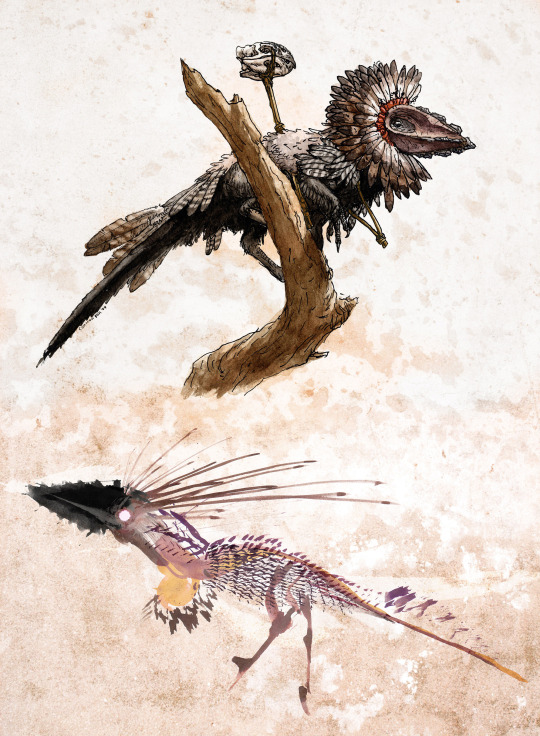
Painting of a ferocious Aegean headhunter.
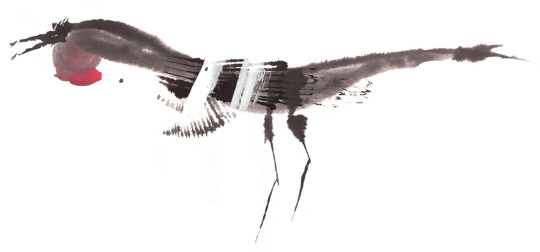
A stylised painting showing an immature dinosauroid.
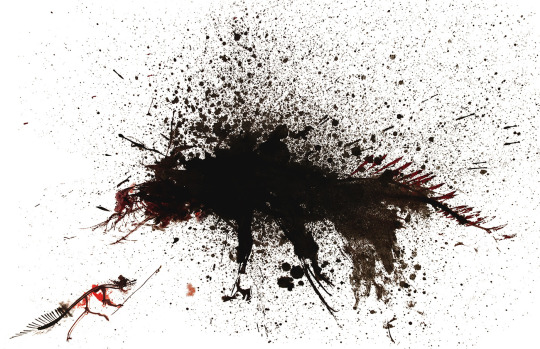
Stylised painting of a warrior confronting a spirit-creature.
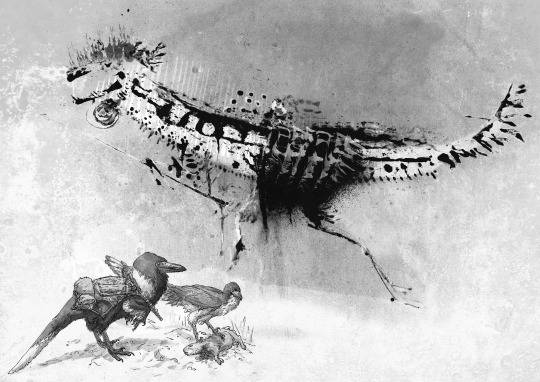
Stylised painting of a powerful Caucausian mountain warrior.

Painting showing a ghoul-like oviraptoriform animal.
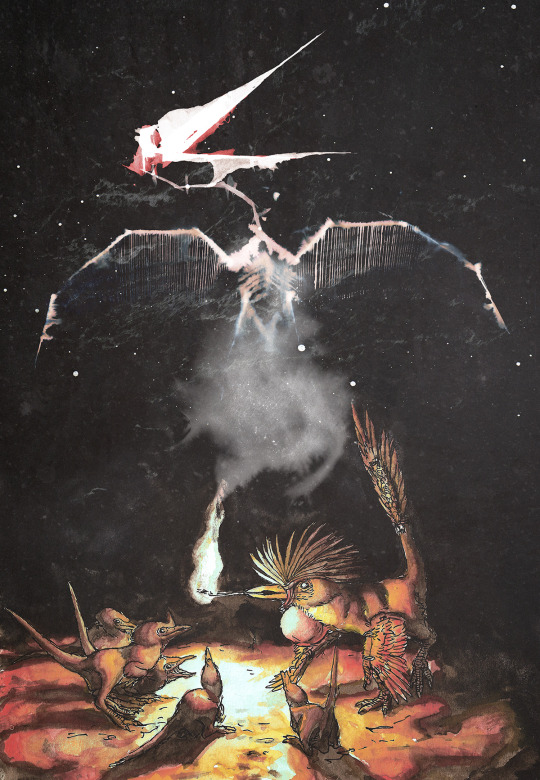
Painting of one of the sky-gods worshipped by A. saurotheos.
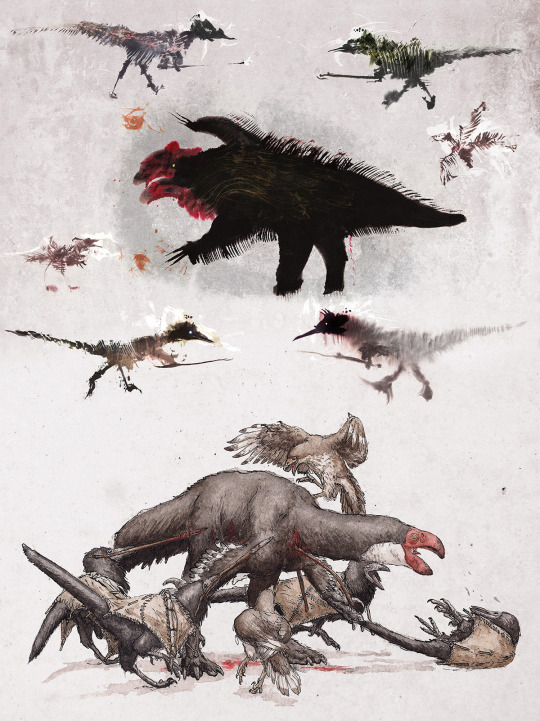
A complex painting showing four A. tataricus warriors hunting a bull Bosornithoides.
Simon Roy and I may return to the dinosauroids universe one day with a real story; but truth be told we enjoyed world-building far more than inventing stories and characters.
- 2008 - 10/2019.
#worldbuilding#speculative biology#speculative evolution#dinosaurs#dinosaur art#dinosauroids#paleoart#creature design#c m kosemen#simon roy
435 notes
·
View notes
Photo










“The plant names alone will show how the temperate regions of the world from the Andes to the Himalayas and from the Blue Mountains to the Caucaus have been ransacked for good plants but they will not show how these plants have been absorbed into a great garden. Plants are after all only the raw material and to weave them into a harmonius whole is to compose a great symphony” Frank Kingdon Ward.
Bodnant’s origins date back to the 17th-century Bodnod, owned by local family the Lloyds, who married into the Hanmer baronets, but was launched in its present for in 1874 when Henry Pochin bought the lands from the Hanmers and set about his work.
Pochin, a businessman from Manchester, was interested in an implausable number of businesses from ships, coal mines, railways (the first of which arrived here in 1879) and as befitted his new status as a country gentleman, he was also a landowner in Prestatyn and Sherriff of Denbighshire.
In his spare time Henry worked with his daughter Laura, a staunch campaigner for women’s suffrage, to develop a beautiful garden here; Laura was ideally placed to inherit in 1895, employing botanists and plant collectors like the above-named Kingdon Ward to harvest plants from around the world and bring them here to be naturalised.
In 1933 Laura, having achieved a great deal in the garden and the world, died and was succeded by her son Henry, who was also a successful businessman and local worthy, and whose keen interest in gardening is shown in (5,6) the Grade II listed Pin Mill which he ordered installed here in 1938, overseen by J Murray Easton and a successful transplanting of an 18th century English structure to Bodnant.
Henry, who also designed (7) the striking Arts and Crafts terraces, gave Bodnant to the National Trust in 1948, though continuing to live here until his death in 1953, and the Trust have run it expertly since, with the help of the family who still live in (8-10) the (private-no public access) Bodnant Hall.
I found probably the best place to appreciate Bodnant, looking from (1) the statue of Laura, carved from willow by Trevor Leat, and thinking that this seemingly tranquil garden came from hard-won Manchester money and other industrial wealth and from Henry and Laura campaiging for the causes they believed in, the victory of which we have all benefited from, so if you come here and look over to Carneddau you should consider the price that was paid for your admission.
1 note
·
View note
Text
Full Documentary | Georgia & The Great Caucasus
Full Documentary | Georgia & The Great Caucasus
Full documentary about Georgia, this country is located in the Caucasus, along the black sea. It is a country with European vocation and western spirit with great landscape and cultural variety.
Georgia. The secret in the Caucasus Georgia has protected its artistic heritage and been able to maintain the vibrancy of its unique…
View On WordPress
#black sea#Borjomi-Kharagauli#caucasus documentary#caucasus mountains#caucasus mountains documentary#caucaus#documentaries#documentary#documentary for free#Europe#free documentaries#full documentaries#full documentary#georgia 2015#georgia caucasus#georgia country#georgia documentary#georgia full documentary#georgia tourism#History#history documentary#kakheti#national park#republic of georgia#tbilisi#tbilisi georgia#visit georgia
0 notes
Text
Group Presentation Preparations, Draft 2
MODULE: (2016) 5IMAG016W.1 Advanced Research Methods
Freedom
Freedom is important because, on Kant’s view, moral appraisal presupposes that we are free in the sense that we have the ability to do otherwise. To see why, consider Kant’s example of a man who commits a theft (5:95ff.). Kant holds that in order for this man’s action to be morally wrong, it must have been within his control in the sense that it was within his power at the time not to have committed the theft. If this was not within his control at the time, then, while it may be useful to punish him in order to shape his behavior or to influence others, it nevertheless would not be correct to say that his action was morally wrong. Moral rightness and wrongness apply only to free agents who control their actions and have it in their power, at the time of their actions, either to act rightly or not. According to Kant, this is just common sense.
Mikhail Bakhtin
Introduction Mikhail Bakhtin was a Russian philosopher, literary critic, semiotician[4] and scholar who worked on literary theory, ethics, and the philosophy of language. He was born in Oryol,in Russian, however latter on following his career years he moved to the small a town Nevel. His manuscripts were written on a variety of subjects, inspired scholars working in a number of different traditions (Marxism, semiotics, structuralism, religious criticism). Although Bakhtin was active in the debates on aesthetics and literature that took place in the Soviet Union in the 1920s. Mikhail Bakhtin decentralized Kant’s ideas to neo- Kanticism, he took Kant’s ideas on self discovery and freedom further into exploring social constructivism.
Bakhtin lived in a long life under Soviet rule, Bakhtin expreinced thw hole range of effects an author can produce, form imprisonment, cencorship to banishment to fame and adulation. The shock of his arrest during Stalin’s terror made him extremely cautios in later years, as well as that Bakhtin, suffered bone illness which affected his interpretation on the world and his consciousness.
Toward a Philosophy of the Act, a fragmented and unfinished essay written by Mikhail Bakhtin, is one of the texts of the 1920s that better let us glimpse the subtle and complex dialogue established by the Russian philosopher with the philosophical field of his time, in particular through an exciting interpretive turn in Kant’s legacy. This paper seeks to discuss how the concept of an apartness between the world of life and the world of culture and the problems of both the attributes of Being and the open eventness of the responsible act are instrumentalized in a way that allows this philosophical turn, setting what accounts for Bakhtin’s first great contribution to occidental thinking. Bakhtin lays out three claims regarding the acknowledgment of the uniqueness of one’s participation in Being: 1. I both actively and passively participate in Being. 2. My uniqueness is given but it simultaneously exists only to the degree to which I actualize this uniqueness (in other words, it is in the performed act and deed that has yet to be achieved). 3. Because I am actual and irreplaceable I must actualize my uniqueness. Bakhtin further states: “It is in relation to the whole actual unity that my unique thought arises from my unique place in Being.” Bakhtin deals with the concept of morality whereby he attributes the predominating legalistic notion of morality to human moral action. According to Bakhtin, the I cannot maintain neutrality toward moral and ethical demands which manifest themselves as one’s voice of consciousness. Taking Kant’s ideas further, Bakhtin introduces an “architectonic” or schematic model of the human psyche which consists of three components: “I-for-myself”, “I-for-the-other”, and “other-for-me”. The I-for-myself is an unreliable source of identity, and Bakhtin argues that it is the I-for-the-other through which human beings develop a sense of identity because it serves as an amalgamation of the way in which others view me. Conversely, other-for-me describes the way in which others incorporate my perceptions of them into their own identities. Identity, as Bakhtin describes it here, does not belong merely to the individual, rather it is shared by all. A crucial argumentative moment of Toward a Philosophy of the Act that seems to deserve more attention than it is usually devoted is one in which Bakhtin is faced with the problem that is mentioned in a wealth of comments from more varied strain, as being that of apartness between the world of culture and the world of life. This schematic reduction is (only) apparently harmless; it is far from being a brief resume of the problem discussed here. In stating that this is a crucial problem, we are not proposing any analytical plethora to the topic in question in the interpretation of the thought of the young Bakhtin. The apartness of the worlds is, alongside other theoretical and methodological problems, a high point of the philosophical debate carried out by Bakhtin and seen in the great aporia of his essay. We are concerned by the importance they attach to it in the methodological repertoire of the first works of Bakhtin, the perception of their destiny in critical fortune of this text.
How both theoretical ideas affect the current society and its values
Daro Sulakauri
Daro Sulakauri is a Georgian photographer, born in 1985, she received degree in International School of Photography in ICP, than moved back to her native Georgia to continue working on reportage of Caucasus region. Today I will focus on her reportage Terror Incognita (2008-2009) which depicts the life of 5.000 Chechen refuges living in the mountainous region of Georgia. After the armed conflict between Russia and Chechnya in 1994, many found shelter in Pankisi Gorge. However, the further of these refuges remains unclear even today.
The Pankisi Gorge region, a remote mountains enclave in the far northeast corner of the Republic of Georgia. Since December, 1994, when war broke out between the Russia- backed central government in Grozny and a determined group of Chechen resistance fighters, Pankisi has witnessed an influx of refugees, from Chechnya. Though not recognised or officially monitored by international agencies, Pankisi has become a refugee from state- sponsored terror for thousands of people who, ironically, are accused of waging terror at home. Chechens have a reputations for rugged individuals, even among the peoples of the Caucasus who – by any standards – are accustomed to rugged conditions and nurture a fierce sense of national pride and independence in light the imperialist tendencies of surrounging nations. By most estimates, approximately 5,000 Chechens escaped the deadly war in Chechnya by fleeing to Georgia.
Her body of work that she had produced explores how freedom can be constractualised, how the well fare of the ocnutry affects the people, and freedom and freedom of speech is manipulated just for the sake of power, destryoning genirations of tradition and culture. The Caucaus region spread across through Russia to Iran, Azerbijan, Georgia, and Turkey, the region is known to be very united and to have ancient traditions that are unbreakable. The migration between Chechnya and Georgia only states how compassionate the people are, and Daro wanted to depict the loss and the beuty at the same time of the small group of Chechen refuges.
0 notes